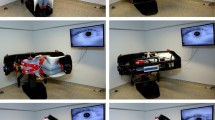Abstract
Even after successful repositioning maneuvers for benign paroxysmal positional vertigo (BPPV), some patients report dizziness lasting for a certain period afterwards. We studied the prevalence and clinical factors associated with residual dizziness in a sample of elderly patients. Sixty outpatients over 65 years of age, affected by idiopathic BPPV were recruited; the exclusion criterion was a history of previous episodes of vertigo, including positional. The patients were asked to describe their self-perceived anxiety for vertigo on a Visual Analogue Scale (VAS) and successively treated with appropriate maneuvers till resolution of nystagmus. Data concerning the demographic and clinical features of BPPV were collected. Patients were followed until complete resolution of subjective dizziness and imbalance without positional nystagmus. Data about residual dizziness were collected from the second day from resolution of BPPV. Clinical and demographic factors related to residual dizziness were analyzed. Twenty-two subjects (37%) reported residual dizziness. In these subjects, the mean duration of residual dizziness was 13.4 ± 7.5 days. No association was observed between residual dizziness and gender, involved canal and the number of repositioning maneuvers before resolution. On the other hand, age older than 72 years, symptom duration greater than 9 days and VAS scale for anxiety greater than 10/100 were associated with an increased risk of residual dizziness. The odds ratio were respectively 6.5 (age—residual dizziness, Confidence Interval 95%), 6.5 (duration of vertigo—residual dizziness, Confidence Interval 95%) and 15.5 (anxiety levels—residual dizziness, Confidence Interval 95%). Longer symptom duration before diagnosis was associated with higher anxiety levels. The results underline the necessity for an early and correct diagnosis of BPPV, especially in the elderly.
Similar content being viewed by others
References
Baloh RW, Hornubia V, Jacobson K (1987) Benign positional vertigo: clinical and oculographic features in 240 cases. Neurology 37:371–378
Von Brevern M, Radtke A, Lezius F, Feldmann M, Ziese T, Lempert T, Neuhauser H (2007) Epidemiology of benign paroxysmal positional vertigo: a population based study. J Neurol Neurosurg Psychiatry 78:710–715
Bhattacharyya N, Baugh RF, Orvidas L, Barrs D, Bronston LJ, Cass S, Chalian AA, Desmond AL, Earll JM, Fife TD, Fuller DC, Judge JO, Mann NR, Rosenfeld RM, Schuring LT, Steiner RW, Whitney SL, Haidari J, American Academy of Otolaryngology-Head, Neck Surgery Foundation (2008) Clinical practice guideline: benign paroxysmal positional vertigo. Otolaryngol Head Neck Surg 139(Suppl 4):47–81
Baloh RW, Jacobson K, Honrubia V (1993) Horizontal semicircular canal variant of benign positional vertigo. Neurology 43:2542–2549
Semont A, Freyss G, Vitte E (1988) Curing the BPPV with a liberatory maneuver. Adv Otorhinolaryngol 42:290–293
Epley J (1992) The canalith repositioning procedure for treatment of benign paroxysmal positional vertigo. Otolaryngol Head Neck Surg 107:399–404
Ganança FF, Gazzola JM, Ganança CF, Caovilla HH, Ganança MM, Cruz OL (2010) Elderly falls associated with benign paroxysmal positional vertigo. Braz J Otorhinolaryngol 76:113–120
Mandalà M, Santoro GP, Awrey J, Nuti D (2010) Vestibular neuritis: recurrence and incidence of secondary benign paroxysmal positional vertigo. Acta Otolaryngol 130:565–567
Yang YS, Hwang CH, Shin JY, Bae WY, Kim LS (2006) Age-related changes on the morphology of otoconia. Laryngoscope 116:996–1001
Olmos Zapata P, Abad Mateos MA, Perez-Jara J (2010) Fear of falling in the elderly with recurrent dizziness: a descriptive study. Rev Esp Geriatr Gerontol [epub ahead of print]
Oghalai JS, Manolidis S, Barth JL et al (2000) Unrecognised benign paroxysmal positional vertigo in elderly patients. Otolaryngol Head Neck Surg 122:630–634
Pritcher MR, Whitney SL, Marchetti GF, Furman JM (2008) The influence of age and vestibular disorders on gaze stabilization: a pilot study. Otol Neurotol 29:982–988
Jackson LE, Morgan B, Fletcher JC, Krueger WW (2007) Anterior canal benign paroxysmal positional vertigo: an underappreciated entity. Otol Neurotol 28:218–222
Gufoni M, Mastrosimone L, Di Nasso F (1998) Repositioning maneuver in benign paroxysmal vertigo of horizontal semicircular canal. Acta Otorhinolaryngol Ital 18:363–367
Lempert T, Tiel-Wilck K (1996) A positional maneuver for treatment of horizontal-canal benign positional vertigo. Laryngoscope 106:476–478
Di Girolamo S, Paludetti G, Briglia G, Cosenza A, Santarelli R, Di Nardo W (1998) Postural control in benign paroxysmal positional vertigo before and after recovery. Acta Otolaryngol 118:289–293
Von Brevern M, Schmidt T, Schonfeld U, Lempert T, Clarke AH (2006) Utricular dysfunction in patients with benign paroxysmal positional vertigo. Otol Neurotol 27:92–96
Pollak L, Davies RA, Luxon LL (2002) Effectiveness of the particle repositioning maneuver in benign paroxysmal positional vertigo with and without additional vestibular pathology. Otol Neurotol 23:79–83
Seok JI, Lee HM, Yoo JH, Lee DK (2008) Residual dizziness after successful repositioning treatment in patients with benign paroxysmal positional vertigo. J Clin Neurol 4:107–110
Stambolieva K, Angov G (2006) Postural stability in patients with different durations of benign paroxysmal positional vertigo. Eur Arch Otorhinolaryngol 263:118–122
Sloane PD, Baloh RW (1989) Persistent dizziness in geriatric patients. J Am Geriatr Soc 37:1031–1038
Faralli M, Ricci G, Ibba MC, Crognoletti M, Longari F, Frenguelli A (2009) Dizziness in patients with recent episodes of benign paroxysmal positional vertigo: real otolithic dysfunction or mental stress? J Otolaryngol Head Neck Surg 38:375–380
Brandt T (1996) Phobic postural vertigo. Neurology 46:1515–1519
Huppert D, Strupp M, Rettinger N, Hecht J, Brandt T (2005) Phobic postural vertigo: a log term follow up (5 to15 years) of 106 patients. J Neurol 252:564–569
Furman JM, Raz Y, Whitney SL (2010) Geriatric vestibulopathy assessment and management. Curr Opin Otolaryngol Head Neck Surg [Epub ahead of print]
Conflict of interest
The authors declare that they have no conflict of interest.
Author information
Authors and Affiliations
Corresponding author
Rights and permissions
About this article
Cite this article
Teggi, R., Giordano, L., Bondi, S. et al. Residual dizziness after successful repositioning maneuvers for idiopathic benign paroxysmal positional vertigo in the elderly. Eur Arch Otorhinolaryngol 268, 507–511 (2011). https://doi.org/10.1007/s00405-010-1422-9
Received:
Accepted:
Published:
Issue Date:
DOI: https://doi.org/10.1007/s00405-010-1422-9




